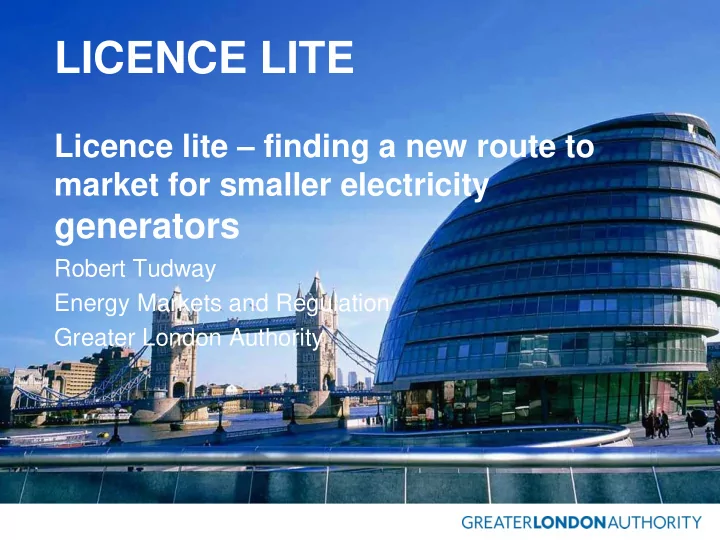

LICENCE LITE Licence lite – finding a new route to market for smaller electricity generators Robert Tudway Energy Markets and Regulation Greater London Authority
Why is the Mayor of London interested in licence lite? • The Mayor is committed to substantial expansion of decentralised energy in London involving both heat and power • These objectives are supported by Government policy and the potential for DE [‘The future of heating –meeting the challenge’ chapter 2] • Licence lite allows for the recovery of value often lost if small packets of power are sold to suppliers wholesale in the market • The economics of L ondon’s decentralised energy production can be substantially enhanced if a more favourable value of the output of smaller scale electricity generation can be realised after deduction of costs, through local supply to specific consumers with compatible consumption profiles.
The business model Net sales revenue and Deduction by the pass through of Tariff paid by GLA of its costs market and consumer from gross contract liabilities revenues received on the supply of the power to the consumer How does the GLA business model support small scale electricity generation? • the underlying principle of the GLA model is to match generation and consumption profiles so as to enhance the value of the generation output for the benefit of both the generators and the consumers • the GLA can aggregate the generation output and the total consumption to enable a deal to be reached with a third party licensed electricity supplier on the GLA’s exposure to the market
How does licence lite work? Licence lite enables a supplier to be licensed, like any other supplier, by relieving the licensee of costs risks and complexities of the electricity market which it is impractical for a small generator /supplier to handle. See Condition 11 standard licence conditions for electricity supply But that is subject to a requirement that the licence lite licensee procure the necessary market services from a fully licensed supplier, enabling the licence lite licensee’s supplies to be handled by the market systems Fully licensed supplier / provider of market interface services Electricity consumer Licence lite generator supplier export (GLA) The value of the licence lite regulatory arrangement is that the junior licensee’s exposure to the costs risks and complexities of the electricity market is a matter of negotiation between the GLA and the third party licensed supplier, since the GLA is not a party to the relevant industry codes.
Will the economics work? • The GLA’s detailed financial model shows the economics work, subject to keeping costs proportionate • A simple business model – initially no domestic consumers / limited numbers of sources of generation and consumers • The Third Party Licensed Supplier has now been appointed (December 2014) The GLA business model is designed around simplicity and the pass through of costs and liabilities to the generators who benefit from the licence lite operation Limited number of Add more commercial Back office/billing costs consumers – consumers and reflective of small financial modelling private sector commercial customer used TfL’s costs sources of base and consumption generation as financial performance and GLA policy permit
How does the GLA’s licence lite model differ from larger scale electricity supply models ? 1. Although generators of any size in any location may tender to provide generating capacity, the GLA licence lite model is local, matching specific sources of low and zero carbon generation with specific consumers and will tend to be more interesting to local sources of electricity generation It matches the length of the supply arrangements and liabilities ‘back to back’ as 2. between consumer and generator 3. As a result the GLA as supplier has a role with likenesses to that of a broker rather than a supplier making margins through dealing in a large wholesale market 4. Domestic consumers and a multiplicity of consumers are avoided until and unless the initial model and its sensitivity to adding new dimensions has been tested, but the objective is to grow 5. The GLA has no direct exposure to the relevant industry codes, its exposure being the extent to which the risks and costs are passed to it under the agreement it negotiates with its fully licensed counterparty
Timing and progress The timing is still speculative because there are limits in predicting the issues arising and the time to resolve them March 2013 GLA made licence lite application to Ofgem and began work on the structure and principles of the business model December 2014 Third Party Licensed Supplier appointed November 2014 to April 2015 Construction of operational arrangements with TPLS / satisfying Ofgem on 11.3 conditions / PPAs with generators / supply agreements with consumers May 2015 Approval of final version of business and financial model and operational matters
Recommend
More recommend